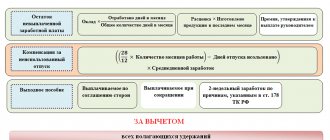In this material, we will understand how additional sick leave is paid to average earnings, we will analyze the basis for receiving it and how to apply for it. We will also analyze tax accounting on the topic, show an example of calculation and answer the most common questions.
The amount of temporary disability benefits depends on the insurance coverage of the employee. But the employer can adjust it to average earnings and pay the difference to the insured person. At the same time, it is important to correctly formalize the additional payment and reflect it on the accounting accounts. This will allow the employer to take into account the costs of additional sick leave as expenses when determining the amount of income tax.
Additional sick pay up to average earnings
Often, sick pay is significantly less than earnings. The employer company can compensate for the resulting difference at its own expense. Such an action is not the responsibility of the employer and is carried out solely on his initiative.
In order for additional payments for sick leave to be taken into account as part of costs, it is necessary to stipulate an obligation to compensate for the difference between the actual benefits and average earnings in the collective agreement. It should clearly indicate the cases in which additional payment will be made.
For example, an employer can pay the difference only if the employee was sick himself and was not caring for a child or a sick family member. The terms of compensation must also be set out in the employment contract.
How to calculate the surcharge?
The amount of the supplement is determined as the difference between the average earnings and sickness benefits.
The average wage is calculated by multiplying the average daily earnings by the duration of disability in days. For the calculation, all income included in the taxable base under the Unified Social Tax is taken into account. When determining the average salary per day, the calculation period is considered to be 1 year preceding the illness.
The amount of the benefit is determined depending on the length of service of the insured person. It varies from 60 to 100% of average earnings. Its maximum value is regulated by law and changes annually.
For example, a factory employee was sick for 7 calendar days in March. His monthly salary is 65,000 rubles. The billing period from February 1 of last year to February 28 of the current year has been fully worked out. Additional sick pay up to average earnings is provided for in collective and labor agreements. Work experience – 7 years.
| Index | Calculation procedure | Result |
| Average salary per day | 65000*12/365 | 2136,98 |
| Sick leave per day | 2136,98*80% | 1709,59 |
| Maximum amount of sick leave per day | 1521,00 | |
| Sick leave amount | 1521,00*7 | 10647,00 |
| Amount of surcharge | 1709,59*7 – 10647,00 | 1320,13 |
Since the maximum amount of temporary disability benefits is limited by law, the company compensates the difference of 1,320.13 rubles.
Concept
Supplementation to average earnings is a procedure in which, if the employee’s income level decreases, the employer pays him an additional amount of money, thanks to which the employee’s salary will reach the average value.
For example, when paying for sick leave, it often turns out that payment is due for temporary disability benefits, the amount of which is significantly lower than the regular salary of a working citizen.
It is for this purpose that some employers transfer an additional amount to the employees’ account.
The decision on additional payment is made by the company’s management independently.
Money paid in addition to sick leave is not compensated by the Social Insurance Fund - the money is taken from the company’s budget.
A similar situation may arise when an employee is transferred to a position in which the citizen’s salary will change for the worse.
It is important to remember that the salary cannot be lower than the minimum wage. Failure to comply with this rule may be considered a violation of the Labor Code of the Russian Federation.
Additional payment of maternity benefits
If the collective and labor agreement stipulates the employee’s opportunity to receive an additional payment up to the average salary for such benefits, then these costs can also be included in labor costs.
The procedure for determining the average salary must be reflected in the local regulations of the employer. If this is not reflected in the documents of the business entity, then the average earnings can be determined in accordance with the current regulations governing the procedure for its calculation.
The Tax Code of the Russian Federation determines that an economic agent has the right to classify expenses for additional payments to maternity benefits up to average earnings as income tax expenses.
The amounts of such additional payments are subject to income tax. Unified social tax is calculated for them. Local regulations of the tax agent in the field of labor legislation may establish an additional payment not only up to average earnings, but also up to:
- official salary. Bonuses and any allowances are not taken into account;
- actual earnings, that is, up to the salary that would have been received by the employee if he had worked for a full month;
- any fixed value that can be set the same for all employees of the enterprise, regardless of salary and job responsibilities. The amount of the additional payment depends on the employer’s financial ability to compensate for the employee’s material losses during illness.
Settlements with employees based on average wages in accordance with the Labor Code of the Russian Federation
The Labor Code provides for many cases when payments to employees are calculated based on average wages.
Accordingly, sooner or later, almost any accountant in his work is faced with the need to make payments to employees based on average earnings.
Vacation and travel allowances, payment for days off to care for a disabled child and payments for layoffs. All these payments are calculated based on the average salary.
This article is devoted to a review of the current legislation regulating cases of maintaining average earnings for employees, as well as methods for calculating it with a clear numerical example.
CASES OF RETENTION FOR AVERAGE EARNING EMPLOYEES
Payment based on average earnings, in accordance with the provisions of the Labor Code, is carried out:








